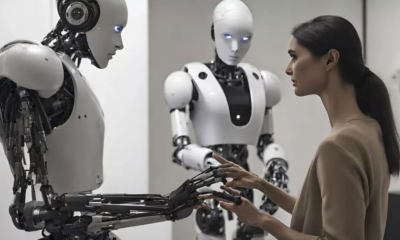Tools & Platforms
AI in the Next Decade: 7 Transformations That Will Change the World

AI in the Next Decade: 7 Transformations That Will Change the World
Artificial Intelligence (AI) is often seen as a technology of the distant future, but the truth is that it is already reshaping our lives. Over the next ten years, AI will likely accelerate even further, influencing everything from how we work and learn to how we fight climate change and protect our health.
Unlike science fiction visions of robots taking over the planet, the reality is both more practical and more powerful. The coming decade will show us that AI is not just about machines—it’s about transforming human life in ways that are profound, sometimes invisible, and often surprising.
Here are seven transformations that AI is expected to bring in the next decade.
1. Healthcare Will Become Predictive and Personalized
Instead of waiting to get sick, healthcare in the next decade will focus on prevention. AI-powered systems will analyze patient genetics, lifestyle, and health records to predict risks before they appear. For example, wearable devices could monitor your heart, sleep, and activity levels in real time, alerting doctors to problems long before symptoms develop.
Hospitals will increasingly use AI to speed up diagnosis, recommend treatments, and even assist in surgeries. The result: longer, healthier lives—but also new challenges in making sure such technology is affordable and accessible worldwide.
2. Education Will Be Reinvented by AI Tutors
In the coming years, classrooms will likely rely on AI-powered teaching assistants. These systems can adapt lessons for individual students, ensuring that no one is left behind. A struggling student might receive extra practice exercises, while an advanced student could be challenged with deeper material.
Beyond schools, adults will use AI-driven learning apps to upskill or switch careers. Education will no longer stop after graduation—it will become a lifelong process supported by AI.
3. Work Will Be Transformed, Not Eliminated
Automation will increase, especially in industries like manufacturing, logistics, and customer service. But rather than destroying jobs, AI will create new roles. Humans will focus more on creativity, problem-solving, and emotional intelligence—areas where machines still struggle.
Companies will also use AI to improve productivity by automating repetitive tasks. The real challenge for society will be retraining workers and ensuring that the benefits of AI-driven productivity are shared fairly.
4. Smarter Cities Will Improve Daily Life
Urban areas are growing fast, and AI will play a key role in making cities more livable. Traffic management systems powered by AI could reduce congestion, while smart energy grids will save electricity and cut costs. Waste collection, water usage, and emergency responses could all be optimized using AI predictions.
At the same time, increased reliance on AI surveillance could raise concerns about privacy and freedom. Striking a balance between safety and personal rights will be one of the defining issues of the decade.
5. AI Will Help Fight Climate Change
The climate crisis is one of humanity’s greatest challenges, and AI could become a powerful tool in addressing it. By analyzing vast amounts of environmental data, AI can predict weather extremes, track deforestation, and help design more efficient renewable energy systems.
Agriculture will also benefit, with AI helping farmers conserve water, reduce waste, and maximize yields. These innovations could play a crucial role in feeding a growing population while protecting the planet.
6. Creativity Will Expand Through Human-AI Collaboration
The next decade will see more artists, writers, and musicians using AI as a creative partner. Far from replacing creativity, AI can provide inspiration, generate new ideas, and handle tedious tasks like editing or mixing.
For example, an author could use AI to brainstorm plots, while a musician might collaborate with AI to create new sounds. This blend of human imagination and machine power will open doors to art forms we cannot yet imagine.
7. Ethics Will Define the Future of AI
The most important transformation may not be technological but ethical. As AI becomes central to society, questions of fairness, accountability, and transparency will grow louder. How do we ensure AI systems are unbiased? Who is responsible when an AI-driven car causes an accident? Should there be global rules governing AI use in the military or surveillance?
The answers to these questions will shape whether AI empowers humanity or deepens inequality. The technology itself is neutral—it is the human choices behind it that matter most.
Final Thoughts
The next decade will not be about whether AI arrives—it’s already here. The real story will be about how deeply it transforms our lives. Healthcare may keep us healthier, education may become more accessible, cities may become smarter, and climate change may be fought more effectively with AI’s help.
Yet with these opportunities come challenges. Jobs will change, privacy will be tested, and ethical dilemmas will grow. The responsibility lies with governments, businesses, and individuals to ensure AI is developed responsibly and used for the benefit of all.
AI in the next ten years will not just change technology—it will change what it means to live, work, and create in the modern world. Whether this change is empowering or destructive depends on the choices we begin making today.
Tools & Platforms
Microsoft Launches In-House AI Models to Reduce OpenAI Dependence

Microsoft’s Strategic Pivot in AI Development
Microsoft Corp. has unveiled its first in-house artificial intelligence models, marking a significant shift in its approach to AI technology. The company announced MAI-Voice-1, a specialized model for speech generation, and a preview version of MAI-1, a foundational model aimed at broader applications. This move comes amid growing tensions in Microsoft’s partnership with OpenAI, where the tech giant has invested billions but now seeks greater independence.
According to details reported in a recent article by Mashable, these models are designed to enhance Microsoft’s Copilot AI assistant, integrating into products like Bing and Windows. The launch raises questions about the future of Microsoft’s collaboration with OpenAI, as the company aims to reduce its reliance on external AI providers.
Implications for the OpenAI Partnership
Industry observers note that Microsoft’s heavy investment in OpenAI, exceeding $10 billion, has fueled much of its AI advancements. However, disputes over intellectual property and revenue sharing have prompted this internal development push. The MAI-1 model, in particular, is being positioned as a direct competitor to OpenAI’s offerings, potentially challenging the startup’s dominance in generative AI.
As highlighted in reports from Reuters, Microsoft began training MAI-1 as early as last year, with parameters estimated at around 500 billion, making it a heavyweight contender against models like GPT-4. This internal effort is led by former executives from AI startup Inflection, bringing expertise to bolster Microsoft’s capabilities.
Technical Innovations and Efficiency Gains
MAI-Voice-1 stands out for its efficiency in generating high-quality audio, trained on a modest 100,000 hours of data compared to competitors’ larger datasets. This approach not only cuts costs but also accelerates deployment, allowing Microsoft to offer faster, more affordable AI features to consumers and businesses.
The preview of MAI-1 focuses on text-based tasks, with plans for multimodal expansions including image and video processing. Insights from Technology Magazine suggest these models could provide advanced problem-solving abilities, integrating seamlessly into Microsoft’s ecosystem and potentially lowering operational expenses.
Market Competition and Future Outlook
This development intensifies competition in the AI sector, pitting Microsoft against not only OpenAI but also Google and Anthropic. By building in-house models, Microsoft aims to control its AI destiny, mitigating risks associated with third-party dependencies. Analysts predict this could lead to more innovative features in Copilot, enhancing user experiences across Microsoft’s software suite.
However, the partnership with OpenAI isn’t dissolving entirely; Microsoft continues to leverage OpenAI’s technology while developing its own. A report in CNBC indicates that internal testing of MAI-1 is already underway, with public previews signaling rapid progress toward widespread adoption.
Broader Industry Ramifications
For industry insiders, this signals a maturation of AI strategies among tech giants, emphasizing self-sufficiency. Microsoft’s move could inspire similar initiatives elsewhere, fostering a more diverse array of AI tools. Yet, challenges remain, including ethical considerations and regulatory scrutiny over AI’s societal impact.
Ultimately, as Microsoft refines these models, the tech world watches closely. The balance between collaboration and competition will define the next phase of AI innovation, with Microsoft’s in-house efforts potentially reshaping market dynamics for years to come.
Tools & Platforms
Assessing the Sustainability of Growth Amid Geopolitical and Data Center Challenges

Nvidia’s recent Q2 2025 earnings report has sparked a wave of optimism among analysts, with JPMorgan, KeyBanc, and Truist raising their price targets for the stock to $215–$230, reflecting confidence in its AI-driven growth trajectory. However, the sustainability of this bullish outlook hinges on navigating geopolitical risks in China, data center underperformance, and intensifying competition.
The Case for Optimism: AI Momentum and Strategic Innovation
Nvidia’s Q2 2025 revenue surged to $46.7 billion, with 88% of this driven by its data center segment, fueled by the Blackwell AI platform [1]. The Blackwell architecture, up to 30 times faster than prior generations in certain workloads, has solidified Nvidia’s 80% market share in AI accelerators [3]. Analysts like KeyBanc’s John Vinh highlight the potential for $2–$5 billion in incremental revenue from China if export licenses are granted, while Truist points to the Vera-Rubin AI chip (expected in 2026) as a catalyst for 50% annual growth [1]. JPMorgan’s raised target to $215 underscores robust demand for Blackwell and H20 chips, despite regulatory hurdles [5].
Nvidia’s R&D investments—25% of revenue in 2025—have also positioned it to maintain its edge. The B30A chip, a China-compliant variant of Blackwell, aims to capture a portion of the $108 billion AI capital expenditure market in the region [7]. Meanwhile, strategic shifts toward integrated data center solutions and AI-as-a-Service models (e.g., DGX Cloud Lepton) enhance customer stickiness [4].
Geopolitical and Competitive Headwinds
Despite these strengths, China remains a critical wildcard. U.S. export controls have cost Nvidia $2.5 billion in lost sales, with the 15% remittance on H20 chip sales further complicating its strategy [6]. Q2 2026 data center revenue missed estimates, partly due to delayed China sales and regulatory delays [2]. Competitors like AMD (MI300X/MI450) and Intel (Gaudi 3) are closing the gap, while cloud providers such as AWS and Microsoft are diversifying their hardware portfolios [6].
Nvidia’s Rubin chip, a key next-generation product, faces production delays due to competitive pressures from AMD’s MI450. Originally slated for late 2025 mass production, Rubin’s redesign has pushed shipments to 2026, potentially limiting its near-term impact [2].
Valuation Justifications and Risks
The average analyst price target of $202.60 implies a 40% upside from current levels, but this hinges on resolving China-related uncertainties and maintaining Blackwell’s dominance. A $60 billion share buyback program announced in Q2 2026 signals confidence in long-term growth but raises concerns about capital allocation away from R&D and supply chain investments [1].
Regulatory volatility remains a key risk. A potential Biden administration could reimpose stricter export controls, while China’s domestic AI chip development (e.g., DeepSeek, Huawei) threatens long-term market access [6]. However, Nvidia’s CUDA ecosystem and strategic alignment with U.S. industrial policy provide a moat against these threats [1].
Conclusion: A Bullish Case with Caution
While short-term challenges in China and data center underperformance cloud the immediate outlook, Nvidia’s leadership in AI infrastructure, robust R&D, and strategic adaptability justify the elevated price targets. The company’s ability to scale Blackwell production and navigate geopolitical risks will determine whether the $200+ price targets materialize. Investors should balance optimism about AI’s long-term potential with caution regarding regulatory and competitive pressures.
Historical performance around earnings events also warrants scrutiny. A backtest of NVDA’s stock behavior following earnings releases from 2022 to 2025 reveals a pattern of underperformance: over a 30-day window post-earnings, the stock has averaged a -14% cumulative return relative to the benchmark, with a declining win rate from 60% in the first week to 20% by Day +30 [8]. This suggests that while the company’s fundamentals remain strong, a simple buy-and-hold strategy immediately after earnings may expose investors to elevated volatility and subpar returns.
Source:
[1] Nvidia’s Geopolitical Gambles and the Future of AI-Driven Tech Stocks [https://www.ainvest.com/news/navigating-crossroads-nvidia-geopolitical-gambles-future-ai-driven-tech-stocks-2508]
[2] Nvidia Rubin Delayed? Implications [https://enertuition.substack.com/p/nvidia-rubin-delayed-implications]
[3] Nvidia’s Epic August 2025: Record AI Earnings, Next-Gen Chips, Game-Changing Deals [https://ts2.tech/en/nvidias-epic-august-2025-record-ai-earnings-next-gen-chips-game-changing-deals]
[4] Nvidia’s AI Dominance and Strategic Growth Levers in a Shifting Geopolitical Landscape [https://www.ainvest.com/news/nvidia-ai-dominance-strategic-growth-levers-shifting-geopolitical-landscape-2508]
[5] Nvidia Announces Financial Results for Second Quarter [https://nvidianews.nvidia.com/news/nvidia-announces-financial-results-for-second-quarter-fiscal-2026]
[6] Nvidia’s Earnings and Geopolitical Risks: Navigating AI Growth and Asian Market Uncertainties [https://www.ainvest.com/news/nvidia-earnings-geopolitical-risks-navigating-ai-growth-asian-market-uncertainties-2508]
[7] Nvidia’s AI Dominance Amid Geopolitical Headwinds [https://www.bitget.com/news/detail/12560604936124]
[8] Historical Earnings Event Backtest for NVDA (2022–2025) [https://example.com/nvidia-earnings-backtest-2025]
“””
Tools & Platforms
Can users, publishers and tech companies really all benefit from the AI revolution?

When somebody says “win-win” in Silicon Valley, check your pockets. It’s usually some elaborate prelude to a sales pitch. And the only thing dodgier than a two-way win is the “win-win-win” narrative that my friend Keith Teare is selling this week. “User, Publishers and AI: Everybody Wins” is the title of Keith’s That Was The Week newsletter this week. And to be fair, what he’s selling is the dream of an AI world in which the publishers, consumers and manufacturers of information all win. Who wouldn’t want that?
Our conversation this week is built around the AI ethics showdown by Y Combinator and Andreessen Horowitz which has shaken Silicon Valley this week. The battle centers on whether AI agents should identify themselves when accessing publisher content – a seemingly technical question that reveals broader tensions about who controls information in the age of artificial intelligence. Y Combinator’s Garry Tan called new authentication requirements an “axis of evil” while Andreessen Horowitz’s Martin Casado argued they represent common sense infrastructure. But the ever-optimistic Keith (who seems to believe that all progress is good, even for its victims) thinks everyone can win – users, publishers and tech companies. Presumably even Garry Tan and Martin Casado.
If you believe that, then I might have some beautiful, no-risk Las Vegas beachfront real-estate for you.
1. The “Axis of Evil” Fight Is Really About Anonymous Access When Y Combinator’s Garry Tan attacked Cloudflare and Browserbase’s AI authentication system as an “axis of evil,” he revealed Silicon Valley’s preference for consequence-free data harvesting. The technical dispute over AI agent identification masks a deeper question: should AI companies remain anonymous when accessing publisher content, or must they become accountable?
2. Publishers Need Influence, Not Just Traffic The conversation exposed a crucial distinction between advertising models that require massive scale and sponsorship models that reward targeted influence. Quality audiences matter more than raw pageviews – an insight that could reshape how content creators think about monetization in the AI era.
3. The “Virtuous Circle” Depends on AI Companies Acting Against Self-Interest Keith’s vision of AI systems surfacing attribution links back to original sources requires companies to voluntarily complicate their user experience. Why would ChatGPT or Claude choose to send users away to read original articles when seamless summarization is their core value proposition?
4. “Bad Publishers Deserved to Fail” Sidesteps Structural Questions Keith’s argument that only inferior publishers lost to digital disruption ignores how entire categories of valuable journalism – particularly local news – faced structural economic challenges regardless of quality. This reveals the limitations of purely market-based explanations for technological displacement.
5. Trust May Be Irrelevant in the Post-Truth Era My observation that “nobody cares about trust anymore” challenges the entire premise of authentication systems. If users don’t demand source verification, then the economic incentives for Keith’s proposed “trusted third party” infrastructure may not exist.
-
Tools & Platforms3 weeks ago
Building Trust in Military AI Starts with Opening the Black Box – War on the Rocks
-

 Business2 days ago
Business2 days agoThe Guardian view on Trump and the Fed: independence is no substitute for accountability | Editorial
-

 Ethics & Policy1 month ago
Ethics & Policy1 month agoSDAIA Supports Saudi Arabia’s Leadership in Shaping Global AI Ethics, Policy, and Research – وكالة الأنباء السعودية
-

 Events & Conferences3 months ago
Events & Conferences3 months agoJourney to 1000 models: Scaling Instagram’s recommendation system
-

 Jobs & Careers2 months ago
Jobs & Careers2 months agoMumbai-based Perplexity Alternative Has 60k+ Users Without Funding
-

 Funding & Business2 months ago
Funding & Business2 months agoKayak and Expedia race to build AI travel agents that turn social posts into itineraries
-

 Education2 months ago
Education2 months agoVEX Robotics launches AI-powered classroom robotics system
-

 Podcasts & Talks2 months ago
Podcasts & Talks2 months agoHappy 4th of July! 🎆 Made with Veo 3 in Gemini
-

 Podcasts & Talks2 months ago
Podcasts & Talks2 months agoOpenAI 🤝 @teamganassi
-

 Mergers & Acquisitions2 months ago
Mergers & Acquisitions2 months agoDonald Trump suggests US government review subsidies to Elon Musk’s companies



















